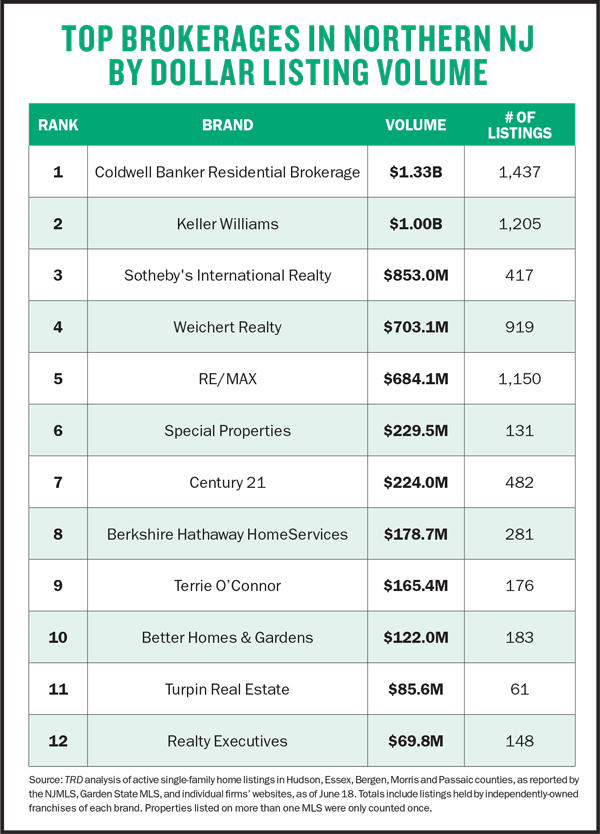Agents at Northern New Jersey’s top-ranking brokerages employ all the tools they can get to stay ahead, but the going isn’t cheap, or easy

(Illustration by Maria Corte)
Staying ahead of the pack in real estate isn’t cheap these days, and the industry certainly isn’t for Luddites. Agents say a combo of ready cash and tech know-how is what it takes to stay on top in New Jersey’s residential market.
“Ten years ago, when Zillow was new, it used to cost me $50 a month,” said Robert Northfield, who runs the Robert Northfield Real Estate Team at Keller Williams. “Now it costs me $5,000.”
Northfield sees little choice but to be part of the Premier Agent program on Zillow, which sends leads to whoever pays for the privilege. “If you are not a Premier Agent, you are not getting those calls, even if you are the listing Realtor,” said Northfield, who is based in Maplewood. “You won’t even get leads on your own listings.”
As industry technology matures, both in terms of engineering and business models, brokers are having to shell out more to stay ahead of the competition — dollars that go to online lead-gen and research platforms, as well as to staffers with the capabilities to stay abreast of emerging tech.
To make sure his 12-person team can compete successfully in New Jersey’s real estate market, Northfield has put money into a data-driven investor desk that helps clients analyze potential purchases, and invested in a specialist who devotes hours every day to correcting errors that appear in online listings.
Northfield and his Keller Williams colleagues must be doing something right: The company landed the No. 2 spot on The Real Deal’s 2018 Northern New Jersey top-brokerages list, which ranked firms in Hudson, Bergen, Essex, Morris and Passaic counties by the dollar value of their active single-family home listings as of June 18. The ranking was based on data from the NJMLS and the Garden State MLS, as well as the firms’ websites. The totals group together listings held by independently owned franchises of each brand
Competition to win listings — and close deals — is intense among the leading brokerages on The Real Deal’s ranking. Coldwell Banker Residential Brokerage took first place on the annual ranking, with $1.33 billion in dollar listing volume across 1,437 properties. Keller Williams was pretty close behind, with $1 billion across 1,205 listings, while Sotheby’s International Realty was a not-too-distant third with $853 million over just 417 listings.
Ratcheting up the stakes is the growing competition traditional brokerages are seeing from tech-oriented independents trying to get in on the action, brokers said. Those entities include eXp, which has a “virtual business” model that keeps its costs for office space down. The company has no desk or franchise fees, and brokers keep 80 percent to 100 percent of commissions, sources said. The company also gives agents a chance to become shareholders, according to its website.
Discount brokerages, such as Redfin, are also upping the ante. “The whole real estate business is going through shifting and restructuring,” Northfield said.
That online marketing bling
Diane Cookson, an agent at Prominent Properties Sotheby’s International Realty in Saddle River, is a big believer in adapting to today’s technology to survive.
“The internet is your first open house,” said the broker. To that end, she hires three different professional photographers to shoot properties for web and social media photos, as well as for her traditional mailers.
But Cookson draws the line at Zillow’s Premier Agent program, though she does list properties on the site. “They wanted $3,000 a month,” she said. “That’s frustrating.”
In addition to advertising on Zillow, Coldwell Banker’s Ghada Abbasi pays to promote listings on Homes.com, MLS.com and Realtor.com. The costs of marketing are going up, the Ridgewood-based broker said, but it’s necessary to have a robust online presence. “Almost 95 percent of consumers, if not more, look up homes online before they even call,” she said.
Victoria Carter, a Short Hills-based broker associate at Weichert Realtors, which grabbed the fourth spot on TRD’s ranking with more than $703 million in listings, stays active on Instagram, Facebook and YouTube. She also advertises on websites like Trulia, Realtor and Zillow.
Leveraging the local
Some brokerages on TRD’s ranking have managed to leverage deep connections in their communities to dominate local markets, making it hard for other firms to encroach on their territory no matter what technology they employ or how much they shell out for online marketing.
In Alpine, Prominent Properties Sotheby’s International Realty had 28 listings with a value of $212.7 million, according to TRD’s calculations. That was far ahead of Coldwell, which, while No. 1 on TRD’s ranking, only had 11 listings with a value of close to $44 million in the Alpine area.
Similarly, in Millburn, Weichert was far ahead of competitors. It had 55 listings in the market worth $125.8 million compared to Keller Williams, which had 47 listings worth $80.7 million in Millburn, according to TRD’s data.
Many of the brokers at these local outposts have been working in the towns for years and get a lot of referral work. The brokerages themselves have been active in those areas for a long time, too, so locals are familiar with their brands, agents said.
Talking tax impact
With President Trump’s tax plan limiting the state and local taxes that buyers can deduct, some buyers are proceeding cautiously, contributing to a climate where brokers in New Jersey say they are working even harder to stay on top.
Without the deductions, prospective buyers are increasingly looking to towns such as Saddle River, known for having lower taxes than comparable communities, brokers said. Prominent Properties’ Cookson said she is seeing considerable tax-consciousness among clients interested in Saddle River, and some have even been emailing home searches to her with the taxes circled. “They’ll say they only want to spend this amount on taxes,” Cookson said. “They’re not only searching on the price.”
Certain submarkets are having a harder time than others because of tax concerns. Kathy Platt, a sales associate at Terrie O’Connor Realtors, pointed to Demarest, where there have been no sales over $2 million this year. “The taxes are very high there,” she said.

The $1 million-and-under market segment is the one with the most activity, agents agreed. “Under $1 million definitely goes right away,” Platt said. “Usually, $1 to $1.5 million goes.”
Many buyers want to avoid the mansion tax, a 1 percent levy on properties at $1 million and above. As a result, Cookson said, selling a property for even $1.1 million is more difficult than it is for one under $1 million.
Selling to savvy shoppers
With interest rates inching up, taking on a big mortgage is also a concern for many buyers. “They want to make sure they’re not overspending,” Cookson said.
With that in mind, she said, young buyers are saving their pennies by leaning toward houses smaller than what they can afford because they want to invest in a vacation property elsewhere.“They’re saying, ‘I’d like to buy a house on the Shore or Nantucket,’” said Cookson. “It’s more important for them to have life experiences than a home that’s 5,000 square feet.”
These days Terry Meese, a sales associate in the Wyckoff office of Terrie O’Connor Realtors, has been working with more buyers in the Franklin Lakes market who are looking to scale back from five- or six-bedroom homes to smaller, more manageable places.
“I am seeing more people looking for single-floor living — more than I’ve seen in quite some time,” she said. “They are looking for ranches.”
But some brokers say that the movement away from larger homes reflects another trend: Many buyers, often busy working couples with children who lack the time (or desire) to spend weekends at Home Depot, are shying away from older homes. Instead of taking on all that work, they are opting for smaller and newer homes, which often are more energy-efficient, too.
“What we have sitting is an inventory of older homes that need updating,” said Platt of Terrie O’Connor Realtors, which ranked No. 9 with $165.4 million in listings and has offices in Allendale, Kinnelon, Ramsey, Ridgewood and Saddle River, among other Northern Jersey locations. Older kitchens and bathrooms or overgrown landscaping are serious liabilities in the current market, she has found.
Buyers are gravitating toward more informal homes, as well. Cookson has noticed they are less interested in seeing homes with ornate interiors and heavy draperies, even in larger homes. One of her sellers recently painted over a $30,000 mural on her ceiling because she felt millennial buyers would not like it. “Buyers want something that is not as formal, more family-style,” she said.
Staging is also increasingly important in the current market, brokers said, and they are increasingly urging their clients to try it. “A lot of sellers are getting on board with the notion it’s worth spending a little bit on staging, relative to the value of the house,” said John Turpin, a broker at Turpin Realtors in Far Hills, which came in at 11th place with $85.6 million in active listings.
Another key marketing tactic — for the lucky brokers and sellers who are in towns on a train line — is heavily promoting the benefits of the easy commutes, a commodity in hot demand at a time when many people who work in Manhattan are contending with the hassles that come with an aging infrastructure. (Read more about pricing in New Jersey’s commuter towns on page 12.)
By the numbers
One of the major current challenges for New Jersey brokers is a low supply of properties for sale. The number of homes of all types on the market statewide dipped by 16.8 percent since last year, according to New Jersey Realtors, and the number of new single-family home listings was down 8.3 percent year over year, to 13,009. Closed sales were down 2.3 percent, the organization reported.
One recent development that could help ease the inventory crunch, albeit very slightly, is that properties once tied up in short sales and foreclosures are coming back on the market, Coldwell’s Abbasi said.
“The banks were holding onto short sales or foreclosures,” said Abbasi. “They are releasing them now. I have a few clients who have bought homes at auction. They came to me to resell them.”
Abbasi just listed a house in Westwood that a client bought at auction. She also listed another property in Woodcliff Lake that the client bought at auction and then sold off without doing many renovations, she said.
In the current market, though, it’s very much the exception, not the rule, for a home that hasn’t been updated to sell, Abbasi said. “If you have a house that is well-improved and in move-in condition, it will sell faster and most likely with multiple offers. If the price is right.”
The dip in inventory has helped drive up pricing. The average sale price for single-family homes rose to $394,627 in May 2018, up from $305,000 the prior year, and the median sale price for all properties rose 2.5 percent, according to New Jersey Realtors.
“If you had to use one word to describe this market, it would be ‘inconsistent,’” said Platt of Terrie O’Connor Realtors. “You put something on the market that you think is too high, and it sells right away — and you put something on that’s perfectly priced, and it won’t sell.”


